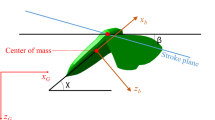Abstract
The aerodynamic interaction between the contralateral wings and between the body and wings of a model insect are studied, by using the method of numerically solving the Navier–Stokes equations over moving overset grids, under typical hovering and forward flight conditions. Both the interaction between the contralateral wings and the interaction between the body and wings are very weak, e.g. at hovering, changes in aerodynamic forces of a wing due to the present of the other wing are less than 3% and changes in aerodynamic forces of the wings due to presence of the body are less than 2%. The reason for this is as following. During each down- or up-stroke, a wing produces a vortex ring, which induces a relatively large jet-like flow inside the ring but very small flow outside the ring. The vortex rings of the left and right wings are on the two sides of the body. Thus one wing is outside vortex ring of the other wing and the body is outside the vortex rings of the left and right wings, resulting in the weak interactions.
Similar content being viewed by others
References
Dudley R., Ellington C.P.: Mechanics of forward flight in bumblebees—I Kinematics and morphology. J. Exp. Biol. 148, 19–52 (1990)
Dickinson M.H., Götz K.G.: Unsteady aerodynamic performance of model wings at low Reynolds numbers. J. Exp. Biol. 174, 45–64 (1993)
Ellington C.P., van den Berg C., Willmott A.P.: Leading edge vortices in insect flight. Nature 347, 472–473 (1996)
Dickinson M.H., Lehman F.O., Sane S.P.: Wing rotation and the aerodynamic basis of insect flight. Science 284, 1954–1960 (1999)
Wang Z.J.: Two dimensional mechanism for insect hovering. Phys. Rev. Lett. 85, 2216–2219 (2000)
Sun M., Tang J.: Unsteady aerodynamic force generation by a model fruit fly wing in flapping motion. J. Exp. Biol. 205, 55–70 (2002)
Usherwood J.R., Ellington C.P.: The aerodynamics of revolving wings—I. Model hawkmoth wings. J. Exp. Biol. 205, 1547–1564 (2002)
Usherwood J.R., Ellington C.P.: The aerodynamics of revolving wings—II. Propeller force coefficients from mayfly to quail. J. Exp. Biol. 205, 1565–1576 (2002)
Fry S.N., Sayaman R., Dickinson M.H.: The aerodynamics of hovering flight in Drosophila. J. Exp. Biol. 208, 2303–2318 (2005)
Sun M., Wu J.H.: Aerodynamic force generation and power requirements in forward flight in a fruit fly with modeled wing motion. J. Exp. Biol. 206, 3065–3083 (2003)
Sun M., Du G.: Lift and power requirements of hovering insect flight. Acta Mech. Sin. 19, 458–469 (2003)
Sun M., Xiong Y.: Dynamic flight stability of a hovering bumblebee. J. Exp. Biol. 208, 447–459 (2005)
Aono H., Liang F.Y., Liu H.: Near- and far-field aerodynamics in insect hovering flight: an integrated computational study. J. Exp. Biol. 211, 239–257 (2008)
Liu H.: Integrated modeling of insect flight: from morphology, kinematics to aerodynamics. J. Comput. Phys. 228, 439–459 (2009)
Liu, H., Aono, H.: Size effects on insect hovering aerodynamics: an integrated computational study. Bioinspir. Biomim. 4 (2009) (in press)
Vogel S.: Flight in Drosophila—II. Variations in stroke parameters and wing contour. J. Exp. Biol. 46, 383–392 (1967)
Dudley R.: The Biomechanics of Insect Flight: Form, Function, Evolution. Princeton University Press, Princeton (2000)
Ellington C.P.: The aerodynamics of hovering insect flight—III. Kinematics. Phil. Trans. R. Soc. Lond. B 305, 79–113 (1984)
Rogers S.E., Kwak D., Kiris C.: Steady and unsteady solutions of the incompressible Navier–Stokes equations. AIAA J. 29, 603–610 (1991)
Rogers, S.E.: On the use of implicit line-relaxation and multi-zonal computations. AIAA Paper No. 91-1611 (1991)
Rogers, S.E., Pulliam T.H.: Accuracy enhancements for overset grids by using a defect correction approach. AIAA Paper No. 94-0523 (1994)
Meakin, R.L.: On the spatial and temporal accuracy of overset grid methods for moving body problems. AIAA Paper No. 94-1925 (1994)
Hilgenstock A.: A fast method for the elliptic generation of three dimensional grids with full boundary control. In: Sengupta, S., Hauser, J., Eiseman, P.R., Thompson, J.F. (eds) Numerical Grid Generation in CFM’88, pp. 137–146. Pineridge Press Ltd, Swansea (1988)
Sun M., Yu X.: Aerodynamic force generation in hovering flight in a tiny insect. AIAA J. 44, 1532–1540 (2006)
Sun M., Lan S.L.: A computational study of the aerodynamic forces and power requirements of dragonfly (Aeschna junces) hovering. J. Exp. Biol. 207, 1887–1901 (2004)
Lan S.L., Sun M.: Aerodynamic properties of a wing performing unsteady motions at low Reynolds number. Acta Mech. 149, 135–147 (2001)
Wu J.H., Sun M.: Unsteady aerodynamic forces of a flapping wing. J. Exp. Biol. 207, 1137–1150 (2004)
Sun M., Wu J.H.: Large aerodynamic force generation by a sweeping wing at low Reynolds number. Acta Mech. Sin. 20, 24–31 (2004)
Author information
Authors and Affiliations
Corresponding author
Additional information
The project was supported by the National Natural Science Foundation of China(10732030) and the 111 Project (B 07009).
An erratum to this article can be found at http://dx.doi.org/10.1007/s10409-009-0315-x
Rights and permissions
About this article
Cite this article
Yu, X., Sun, M. A computational study of the wing–wing and wing–body interactions of a model insect. Acta Mech Sin 25, 421–431 (2009). https://doi.org/10.1007/s10409-009-0266-2
Received:
Revised:
Accepted:
Published:
Issue Date:
DOI: https://doi.org/10.1007/s10409-009-0266-2




